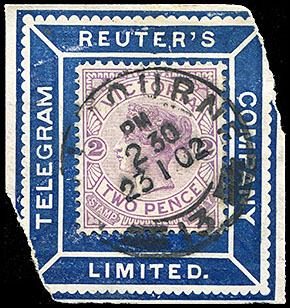Reuter's Telegram Company.
- Australia 1901-1988
- New South Wales
- Queensland
- South Australia
- Tasmania
- Victoria
- Western Australia
- International
- Special aspects
The following references are included on this page:
- a brief summary of the main aspects of Reuter's establishment and early history in Australia.
- a listing of the addresses of Reuter's Offices in Australia;
- Messengers;
- examples of advertisements outlining their services in Australia.
On other pages, there are examples of:
1. Brief overview of the early history of Reuter's in Australia.
The well-known Reuters dates from a text news service founded in Great Britain by Julius Reuter in 1851. He established an office to transmit information between the London and Paris stock exchanges.
The Reuter's Company operated in Australia from 1860. By 1869, the Company had obtained exclusive rights to Australia and the Far East.
For the first few years, Reuter's operated though its appointed Agent Greville's Telegraph Company. It then operated independently as a Telegraphic Company in Australia for a number of years. The focus of its service was solely concerned with messages between England and other Reuter’s bases in the British Empire and Australia and not with domestic services.
In 1872, the cost of a cable to London was 10/- per word. An agreement to supply news to major Australian dailies took effect from 21 October 1872.
There was an exclusive arrangement between Reuter's and Australian Associated Press which in turn allowed the Argus and the Sydney Morning Herald to be the only newspapers to receive the foreign news. John Byron, who had formerly worked at Greville's, opened an office in 1877 in London to provide foreign news to those newspapers which had been excluded from the arrangement. Reuter's offered to buy Byron out but he refused. Reuter's soon began to regret the exclusivity of the arrangement and tried to modiy their contractual obligations.
The continuing dominance of the telegram over other forms of communication was reiterated when Reuters reported the Armistice which ended World War I in many places of the world even before the British Government’s official announcement.
Reuter's profitability in Australia depended not so much on the news services but on commercial activities, especially private telegrams and transferring funds within Australia and overseas.
With the inauguration of the Port Darwin to London cable and the link to the Overland Telegraph line to Adelaide, the Reuter's Telegram Company formed a long network of offices in the intervening countries to ensure communications were maintained. When there were interruptions, alternative strategies had to be put in place. For example, following an interruption to the cable in December 1877, the following notice was posted:
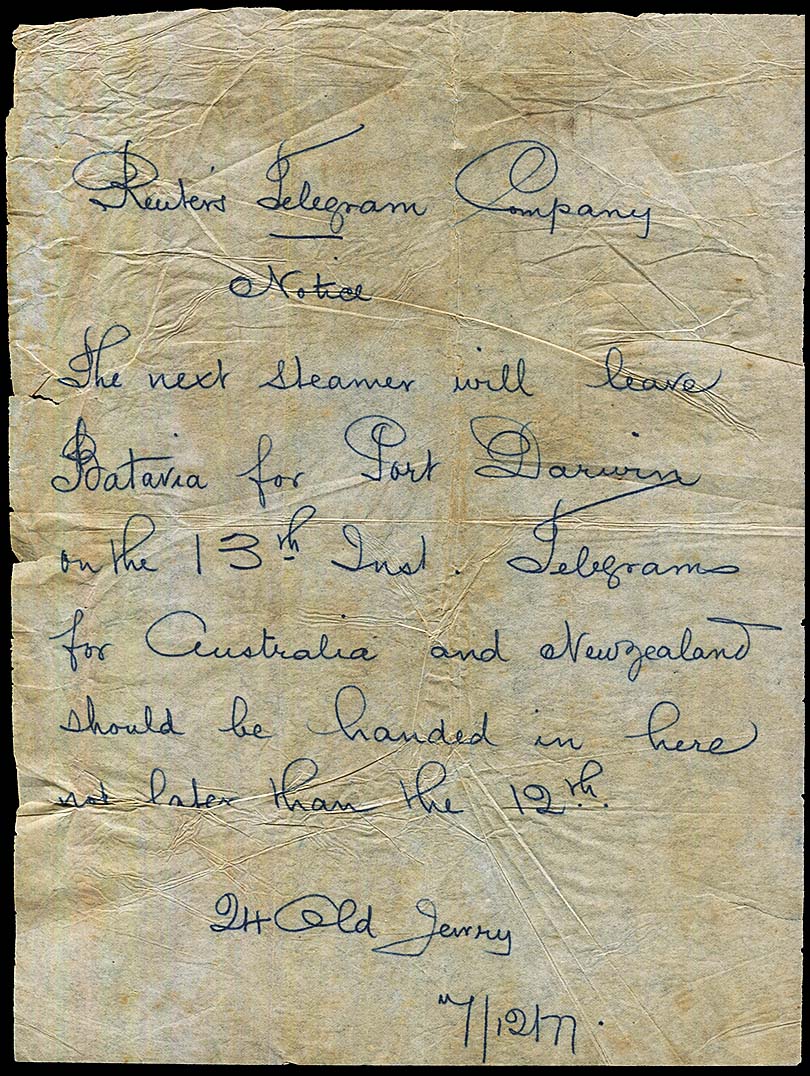 |
2. Location of Reuter's Offices in Australia.
The company opened Offices in:
| Colony/State | Address | |
| Melbourne (Central Office in Australia) |
The Exchange. | 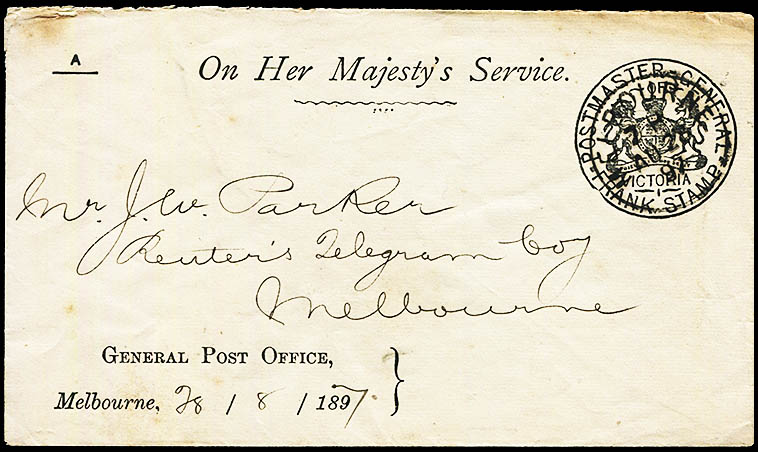 Cover to Reuter's Telegraph Company in Melbourne - note an address was unnecessary to include. 28 August 1897. Has a Melbourne datestamp over a Postmaster-General Frank stamp in black. |
| Brisbane | ||
| Sydney | 110 Pitt Street. | 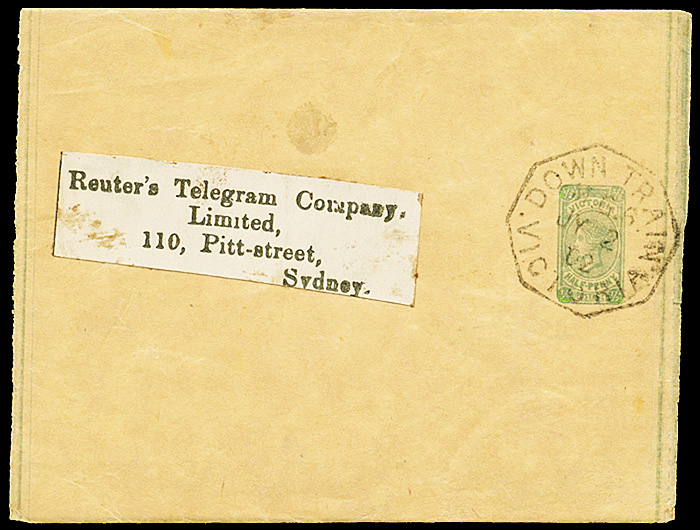 2 July 1902. Provenance: Max Watson. Mossgreen April 2017, Lot 395. |
| Broken Hill | Bayley Street | The Office was one of the many totally destroyed by the big fire on 9 October 1895. |
| Hobart | ||
| Launceston | ||
| Adelaide | Broken Hill Chambers, | |
| Perth | ||
| Kalgoorlie | No. 4 Westralia Chambers. |
| Like the Telegraph Offices, Reuter's employed messengers to deliver its cables.
There is no information about these messengers in any of the Australian Offces. There is however one historic image of a lovely girl who was a messenger for Reuter's in London.
Contrasts markedly with the uniforms some messengers might wear today in some areas - but this messenger did live in London. |
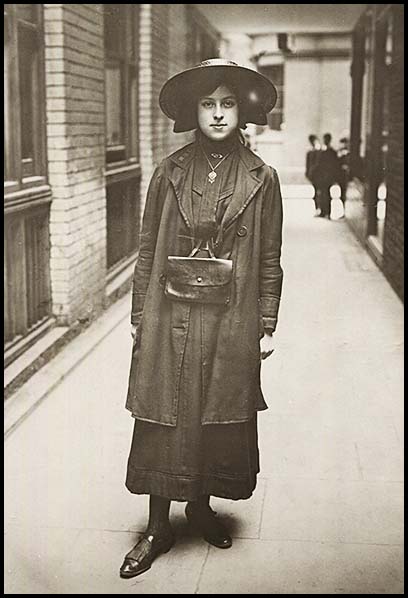 |
4. Examples of early advertisements promoting Reuter's services.
Advertisements were lodged in various newspapers to promote the company's services. For example, the following advertisement appeared in the Kalgoorlie Miner of 9 July 1896:
REUTER'S TELEGRAM COMPANY, Limited.
KALGOORLIE AGENCY
No 4 WESTRALIA CHAMBERS.The Company offers special facilities for the transmission of Telegrams to the United Kingdom, the Continent of Europe and America. Telegraphic Addresses of Sender and Receivers registered free of charge under one word. The Company's extensive codes of 350,000 phrases placed at the disposal of Senders by which the cost of Telegrams can be greatly reduced. Money remitted to and from the United Kingdom on lowest terms. Special cyclist employed for the delivery of telegrams throughout the district.
W. K. DAVIS.
Agent.
The following advertisement in the Adelaide Register of 1 May 1906:
REUTER'S TELEGRAM COMPANY LIMITED
BROKEN HILL CHAMBERS, ADELAIDE.REUTER'S free Cable Addresses embrace both sender and receiver.Great economy effected by using Reuter's new code of half a million phrases.
Messages in this code translated before delivery.
Mail and telegraphic remittances at lowest rates to all places within and beyond Australasia.
Phone 511.
See the Reuter's delivery form and the Reuter's receipts for implications of this advertisement.
